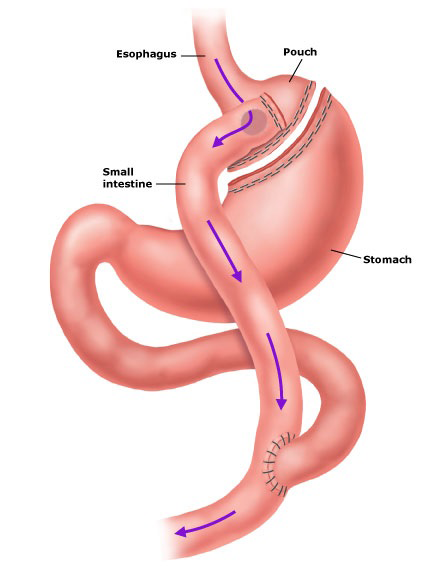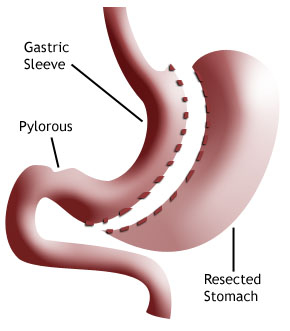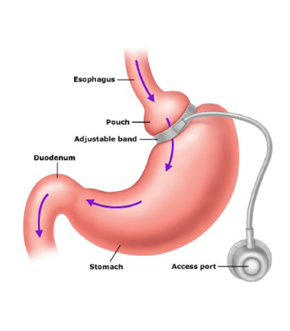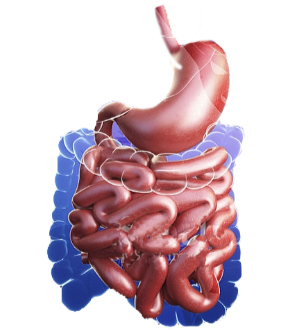
Gastric Bypass surgery has been performed for weight loss since 1966. The Roux-en-Y gastric bypass is a safe and effective procedure. It creates a small stomach pouch that allows an individual to feel satiated from eating a small meal. The procedure causes a degree of maldigestion and malabsorption.
The Gastric Bypass surgery is performed under general anesthesia and takes approximately 1 hour 15 minutes. Most patients can expect to be in the hospital for two nights.
The Gastric Bypass causes both restriction and some malabsorption of food. The restriction comes from the small size of the new stomach pouch. The malabsorption comes from the food bypassing a portion of the small intestine (the duodenum and a portion of the jejunum), so fewer calories and nutrients are absorbed. Studies show that bypassing this portion of the upper digestive tract appears to result in increased levels of a hunger-suppressing hormone called GLP (glucagon-like polypeptide). This hormone is also partly responsible for the improvement of blood sugar regulation in Type 2 diabetic patients immediately after surgery.
The new stomach pouch can hold about an ounce of food at one time. It is important that you consume food and liquids at a rate not to exceed one ounce every five minutes. By eating larger amounts of food or by eating too fast, you may stretch the pouch over time.
The majority of your weight loss will occur during the first 12 to 18 months after surgery. The goal during this time is to develop healthy eating and lifestyle habits that will enable you to maintain the weight loss for the rest of your life!
What changes occur to the digestive system after gastric bypass surgery?
- The first physical change that occurs is that the size of your stomach is made smaller. The stomach is separated into 2 parts. Your smaller stomach is referred to as a pouch, which is about the size of an egg.
- The stomach is separated with the use of staples to create a small pouch. The small stomach pouch causes the restrictive part of the gastric bypass surgery. The remaining part of the stomach is left in place to continue producing digestive juices.
- The middle part of the small intestine (jejunum) is cut and one part is brought up to the stomach pouch where it is attached (anastomosed) to create the bypass effect for food. This attachment site is called gastro-jejunostomy. The food now bypasses the large part of the stomach and the first part of the small intestine causing malabsorption of food. Malabsorption means a decreased absorption of calories/nutrients.
- The other end of the small intestine is attached (anastomosis) back to the small intestine (jejunum). This limb is also known as the Bilio-pancreatic limb. This limb carries digestive juices from the remaining stomach, pancreas, liver and duodenum into the lower portion of the small intestine.
The Benefits of The Gastric Bypass Procedure
- The stomach is stapled creating a workable small pouch
- A small stomach means smaller, more normal, portions
- Laparoscopic procedure
- 90-minute average surgical time
- Low surgical risk percentage of 1.49%
- Discharged usually the 2ndor 3rd day after surgery
- Return to a non-physical strenuous job in 14 days
- Average weight loss is 2 to 3 pounds per week (Based on following TSB dietary and exercise guidelines)
- After 1 year, patients can lose up to 70% of excess weight
Permanent Lifestyle Changes Patients who learn to make the necessary dietary and lifestyle changes are able to achieve sustained weight loss. But patients who do not fully commit to the necessary dietary lifestyle changes may see weight regain at about 2 years out from surgery. Weight regain occurs because of grazing (cheating a little here or there), not paying attention to those additional calories being consumed in the form of high-calorie drinks, or eating more food than is recommended.



